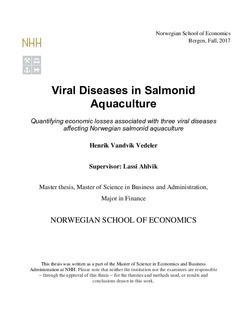| dc.description.abstract | The salmonid aquaculture industry has a unique level of commercialization and technological
development relative to other aquaculture industries. Even so, diseases and other biological
challenges are still a key concern for the industry, and limit the industry’s ability to grow. One of
the most important disease challenges are those presented by viral diseases. A lack of aggregated
estimates for economics losses associated with outbreaks of some viral diseases motivated the
definition of the problem researched in this thesis: “How large are the aggregated economic losses
associated with viral disease outbreaks in Norwegian salmonid aquaculture”. The required data is
at the time of writing only available for Norway.
The research problem was analyzed through a simulation model built on a partial budgeting
framework. The model’s framework was based on published literature within animal health
economics, and similar exercises. Costs related to outbreaks was divided into biological losses,
cost of prevention, -treatment, other extraordinary costs, and insurance payout. Actual reported
biomass- and feeding data from all Norwegian salmonid farming sites was utilized in the model, in
addition to both primary- and secondary sources for other model inputs. Based on available and
obtained data, outbreaks between 2012 and 2016 of Pancreas disease (PD), Infectious Salmon
Anemia (ISA) and Cardiomyopathy Syndrome (CMS) was included in the simulation model. The
study had full coverage of outbreaks in Norway for 2014 and 2015.
The simulations show that PD caused direct costs for Norwegian farmers in 2015 of 2366 – 2775
NOKm, ISA 873 – 936 NOKm and CMS 647 – 848 NOKm. The simulation results show that the
total aggregated direct costs associated with these viral disease outbreaks are an important source
of economic losses in Norwegian salmonid aquaculture. The combined simulated losses from the
three analyzed diseases are of a magnitude where they equate to four-fifths of previously published
estimates on the direct costs associated with salmon sea lice in Norway. The results vary by year,
but the study displays that particularly direct costs associated with PD are stable year-over-year.
The study further analyzes the implications of secondary infections with PD and CMS, and
explores and discuss time- and geographic differences between outbreaks of each disease. Finally,
the study analyze biological implications of outbreak using the production data.
The methodology applied in this thesis can be extended to cover more diseases and countries. | nb_NO |
